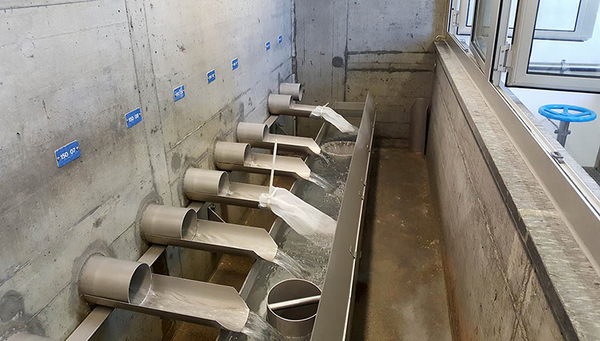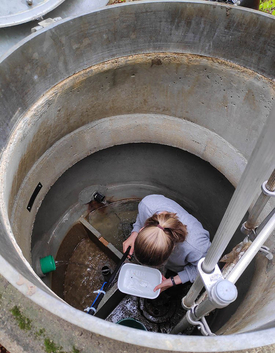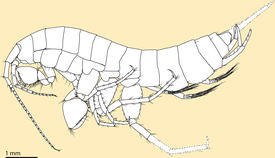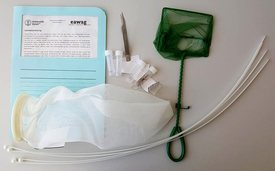News Detail
Aquatic life underground
June 29, 2021 |
With a length of two centimetres, amphipods are not particularly large even in surface waters, but in groundwater they are tiny. They usually measure between one and ten millimetres. A team led by Prof Florian Altermatt of the aquatic research institute Eawag has investigated the species of amphipods and other organisms found in Swiss groundwater and discovered four new amphipod species.
The fact that groundwater is also an aquatic habitat has been known for a long while and has been documented over a considerable period of time in certain regions of Europe. But, says Roman Alther, lead author of the study: "Knowledge of the diversity of subterranean organisms is still fragmentary, even in a country like Switzerland where the animal world is relatively well studied." Now basic knowledge concerning the diversity of life underground is to be compiled in Switzerland. "It is important to protect this biodiversity as well," says biologist Alther, "because subterranean ecosystems provide important services for us, such as drinking water." As a reminder: about 80 percent of drinking water in Switzerland is obtained from groundwater.
New species of amphipods discovered
In their pilot study, Florian Altermatt’s group has now laid the foundation for a nationwide inventory. Groundwater samples from 313 sites in the cantons of Aargau, Basel-Landschaft, Solothurn and Zurich revealed a diverse range of previously undocumented aquatic fauna: these include organisms from various significant groups of invertebrates, in particular crustaceans. The researchers were particularly interested in the cave amphipods (Niphargus), a genus of amphipods. Individuals of eight species were found in the groundwater samples, two of which (N. fontanus and N. kieferi) were found for the first time in Switzerland. In addition, the researchers discovered four phylogenetic lineages previously unknown to science, which could be new species. One of these has now been formally described as the new species Niphargus arolaensis the Aare groundwater amphipod.
Cooperation with drinking water supply practitioners
What is special about the study of the groundwater fauna is not least how the researchers proceeded with the data collection. When taking groundwater samples, they relied on the support of water supply managers. In order to publicise the research project among drinking water suppliers, the project was presented in personal letters, at a specialist conference and in direct discussions. This approach achieved resounding success: out of 130 water supply managers who showed a closer interest in the project, 82 finally agreed to take samples.
"The interest and willingness to help that we have encountered from the water supply managers have been fantastic."
Roman Alther.
The water supply managers had to proceed according to a precisely defined protocol and use material supplied by the researchers. The most important step was to attach a filter bag to the drainage pipes through which the groundwater flows into the well chambers. All the material washed in from the groundwater layer over the course of a week was collected in it. The water supply managers then removed all the organisms from the bags and sent them to Eawag packed in a container filled with ethanol. "The interest and willingness to help that we have encountered from the water supply managers have been fantastic," says Roman Alther.
The sampling material with which the water supply managers involved in the project were equipped. Photo: Nicole Bongni
The citizen science approach with a selected group of citizen researchers will also be part of the already planned expansion of the project. Over the next few years, data will be collected from several hundred well chambers spread throughout Switzerland. The objective is to provide a nationwide overview of groundwater biodiversity. In future, the environmental DNA method will also be used. For example, skin particles or faeces from living creatures are sufficient to document their presence.
Quality control with bioindicators
One of the objectives of the extended project is to establish basic information in order to be able to use the amphipods and their occurrence as a possible indicator of groundwater quality. So far, the quality of the groundwater has been examined on the basis of physical-chemical parameters and the contamination with bacteria determined. In surface waters, on the other hand, the monitoring of water quality with the help of bioindicators is widespread. They are considered as sensors for very low-threshold or long-term pollution and can integrate several factors. "There are no indicators for the groundwater so far," says Roman Alther, "but basically a presence of amphipods and other species is a good sign."
Cover picture: Nicole Bongni
Original publication
Funding
- Federal Office of the Environment FOEN
- Swiss National Science Foundation SNSF
- Slovenian Research Promotion ARRS




